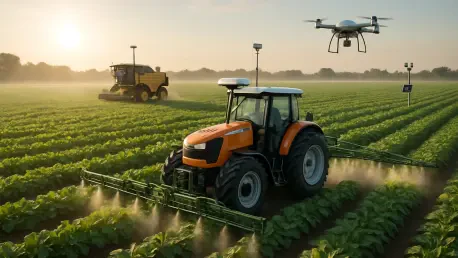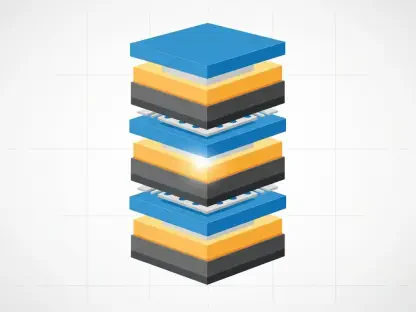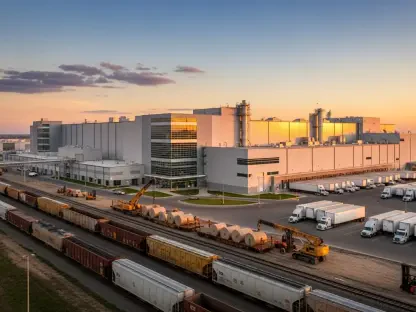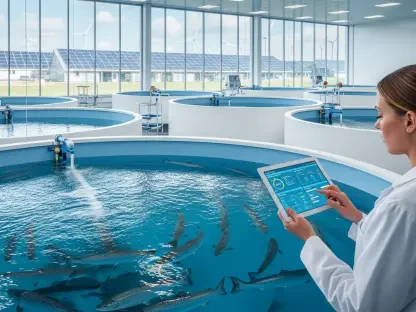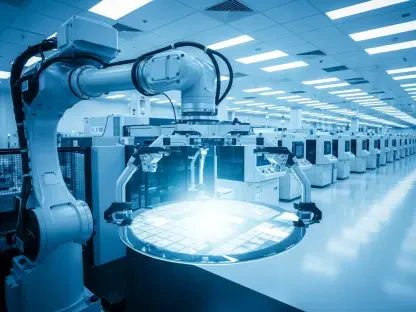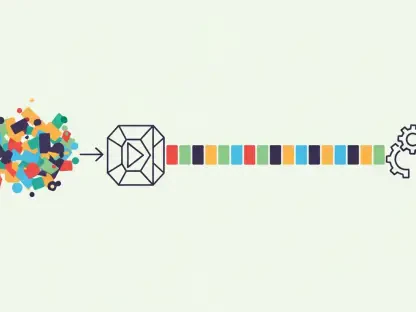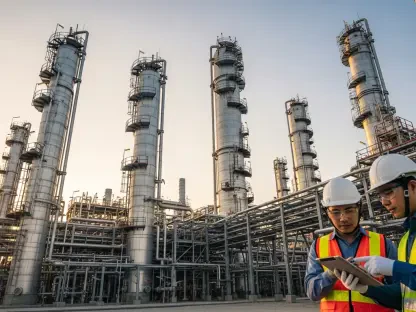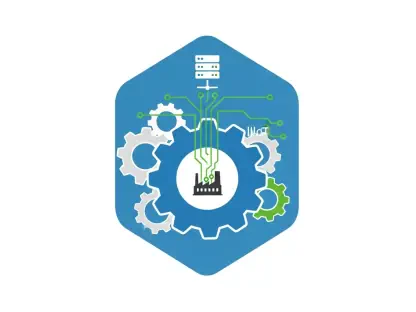Imagine stepping onto a farm where every seed planted, every drop of water used, and every harvest gathered is guided by invisible digital hands—sensors, algorithms, and robots working in perfect harmony to optimize production. This is no distant dream but the tangible reality of Agriculture 4.0, a technological wave transforming the backbone of food production. With the global population projected to reach 9.6 billion by 2050, the pressure on agriculture to produce more with less has never been greater. Traditional methods, once sufficient for smaller communities, falter under the weight of modern demands. Agriculture 4.0 steps in as a beacon of hope, integrating advanced tools like the Internet of Things (IoT) and Artificial Intelligence (AI) to create a smarter, more sustainable farming landscape. This digital shift promises not only to meet escalating food needs but also to address environmental challenges head-on. What exactly does this revolution entail, and how is it reshaping the fields that feed the world? Let’s explore the mechanisms driving this change.
Tracing the Shift From Manual to Digital Fields
The journey of farming stretches back centuries, evolving from labor-intensive, small-scale plots to expansive operations that now define modern agriculture. In the United States alone, the average farm size stands at 446 acres, with some sprawling over 2,900 acres—an unimaginable scope for manual oversight. As the scale of farms ballooned to meet the needs of a growing population, reliance on rudimentary tools became impractical. Agriculture 4.0 marks the latest chapter in this evolution, moving beyond mere mechanization to a fully digitized approach. Sensors and data analytics now stand in for human eyes, monitoring vast fields with precision that no individual could achieve. This transition reflects a broader recognition that feeding billions requires not just more land or labor, but smarter systems capable of adapting to complex, ever-changing conditions.
This digital transformation isn’t merely about keeping up with scale; it’s about redefining efficiency in an era of scarce resources. Where farmers once depended on intuition honed over generations, they now tap into real-time data streams that reveal the health of soil, crops, and even weather patterns. Agriculture 4.0 builds on the foundation of past innovations like tractors and irrigation systems, but it introduces a layer of intelligence that anticipates needs rather than reacts to them. The shift from hands-on toil to high-tech management allows for a level of control previously unimaginable, ensuring that every decision, from planting to pest management, is informed by hard evidence. This isn’t just a technological upgrade—it’s a fundamental rethinking of how agriculture operates in a world where every ounce of productivity counts.
Unlocking Precision Through IoT and AI Innovations
At the core of Agriculture 4.0 lies the seamless integration of the Internet of Things (IoT) and Artificial Intelligence (AI), tools that bring unprecedented precision to farming. Across sprawling fields, IoT sensors quietly gather data on soil moisture levels, nutrient content, and plant vitality, transmitting this information instantly to centralized systems. This constant flow of insights allows farmers to address issues like drought or disease before they spiral into crises. Meanwhile, AI takes this data and transforms it into actionable strategies, drawing from vast databases to recommend optimal planting times or crop varieties. Projects at institutions like North Carolina State University are pioneering this approach, compiling extensive image libraries to train AI models that can identify crop stress or weed infestations with startling accuracy.
The beauty of these technologies is their adaptability to farms of varying sizes, ensuring that even smaller operations can reap the benefits. AI-driven platforms analyze not just immediate field conditions but also long-term trends, helping farmers plan rotations or predict market demands through cloud-based tools. This level of foresight minimizes waste and maximizes output, a critical advantage when resources like water and fertilizer grow scarcer. Beyond day-to-day management, IoT and AI foster a deeper understanding of agricultural ecosystems, revealing patterns that human observation might miss. For instance, subtle shifts in soil composition could signal future challenges, and these systems provide early warnings that save both time and money. As these tools become more accessible, they democratize advanced farming techniques, empowering a wider range of producers to compete in an increasingly complex industry.
Redefining Labor With Automation and Robotics
Automation stands as a pillar of Agriculture 4.0, fundamentally altering the labor dynamics of farming through the deployment of robotics. Experts envision fields where robots—ranging from a single unit to fleets of twenty—handle tasks like planting, weeding, and harvesting with mechanical precision. Dr. Steven Mirsky from the U.S. Department of Agriculture draws parallels to industrial automation, where machines execute repetitive processes while human oversight focuses on strategy and innovation. These robotic systems are engineered to operate tirelessly, reducing the physical burden on farmers and addressing labor shortages that plague rural areas. The result is a streamlined workflow that not only boosts productivity but also cuts down on operational errors that can cost dearly in terms of yield.
Beyond mere efficiency, robotics in agriculture aligns closely with sustainability goals that are increasingly non-negotiable. Automated systems optimize resource use, applying water, pesticides, and fertilizers only where needed, thus minimizing environmental impact. A robot equipped with sensors can detect exactly which plants require treatment, avoiding the blanket applications that often lead to runoff and pollution. This targeted approach ensures that every input is maximized, preserving both the land and the bottom line. As technology advances, the scalability of robotic solutions means that even modest farms can adopt a single unit to start, gradually integrating more as budgets allow. This flexibility marks a significant departure from past innovations that often favored large-scale operations, signaling a future where automation could level the playing field across the agricultural spectrum.
Navigating the Challenges of Technological Integration
Despite the transformative potential of Agriculture 4.0, the path to widespread adoption is fraught with obstacles that cannot be ignored. The financial burden of investing in cutting-edge tools like IoT sensors, AI software, and robotic systems poses a significant barrier, particularly for smaller farms operating on tight margins. The delay in seeing tangible returns on these investments further complicates the decision to adopt, as farmers must weigh immediate costs against uncertain future gains. Beyond economics, there’s a steep learning curve involved—mastering these technologies requires training and a willingness to depart from time-tested methods. This challenge mirrors broader struggles in engineering fields, where innovation often meets resistance until its value is proven beyond doubt.
Cultural and practical hesitations add another layer of complexity to the adoption of digital farming tools. Many farmers, rooted in traditions passed down through generations, may view technology with skepticism, questioning its reliability compared to their own hard-earned experience. Convincing them to trust data over instinct demands not just evidence of effectiveness but also accessible support systems to ease the transition. Additionally, the benefits of Agriculture 4.0—such as enhanced food security and reduced environmental harm—aren’t always immediately measurable in dollars and cents, making it harder to justify the upfront expense. Addressing these concerns requires a nuanced approach that acknowledges both the tangible and intangible advantages of digital agriculture, ensuring that the push for innovation doesn’t alienate the very communities it aims to serve.
Building Bridges Through Collaborative Efforts
The success of Agriculture 4.0 hinges on collaboration, a collective push involving tech developers, researchers, policymakers, and farmers to overcome the hurdles of implementation. Bridging the gap between cutting-edge innovation and on-the-ground application demands tailored solutions, such as subsidies or shared technology platforms that reduce costs for smaller operations. Policymakers play a critical role in creating frameworks that incentivize adoption, whether through grants or tax breaks, while researchers must continue refining tools to ensure they’re user-friendly and effective across diverse farming environments. This teamwork is essential to ensure that the digital revolution doesn’t bypass smaller players in favor of industrial giants.
Equally important is the focus on education and infrastructure to support this technological shift. Training programs can demystify tools like AI and robotics, equipping farmers with the skills needed to integrate them into daily routines. Meanwhile, investments in rural connectivity—such as reliable internet access—are vital to power IoT systems that rely on real-time data. Collaborative efforts must also prioritize scalable solutions, like single-robot setups, that allow farms of all sizes to dip their toes into Agriculture 4.0 without overwhelming financial risk. By fostering an ecosystem where knowledge and resources flow freely, the agricultural community can build a future where technology enhances rather than disrupts, ensuring that the benefits of this digital era are felt from the smallest family farm to the largest corporate operation.
Paving the Way for a Sustainable Agricultural Future
Reflecting on the strides made, Agriculture 4.0 emerged as a response to the mounting pressures of population growth and resource scarcity, weaving IoT, AI, and robotics into the fabric of farming. These advancements tackled inefficiencies head-on, replacing guesswork with precision and manual labor with automation, while always aiming for a balance with sustainability. The journey wasn’t without friction—financial and cultural barriers slowed the pace of change, testing the resolve of innovators and farmers alike. Yet, through persistent collaboration, solutions took shape, gradually making technology a trusted ally in the fields. Looking ahead, the focus must shift to actionable steps: expanding access to affordable tools, bolstering rural infrastructure, and fostering continuous dialogue among stakeholders. Only by sustaining this momentum can the agricultural sector ensure that the digital revolution fulfills its promise, securing food for billions while safeguarding the planet for generations to come.
